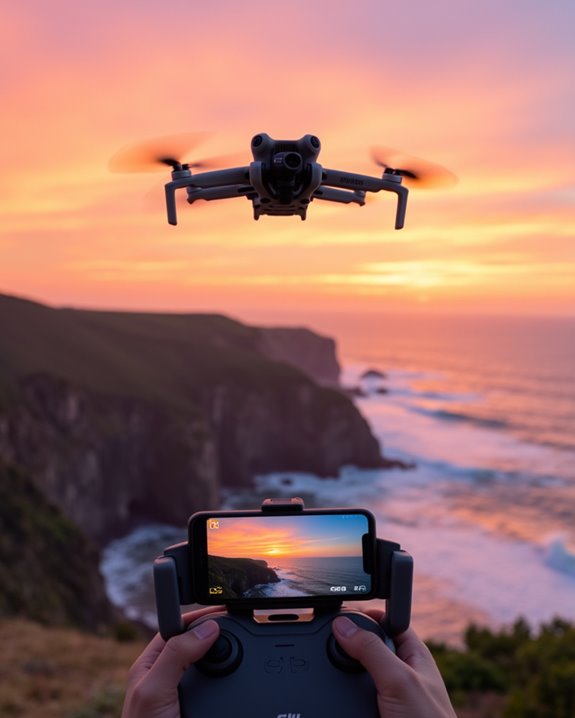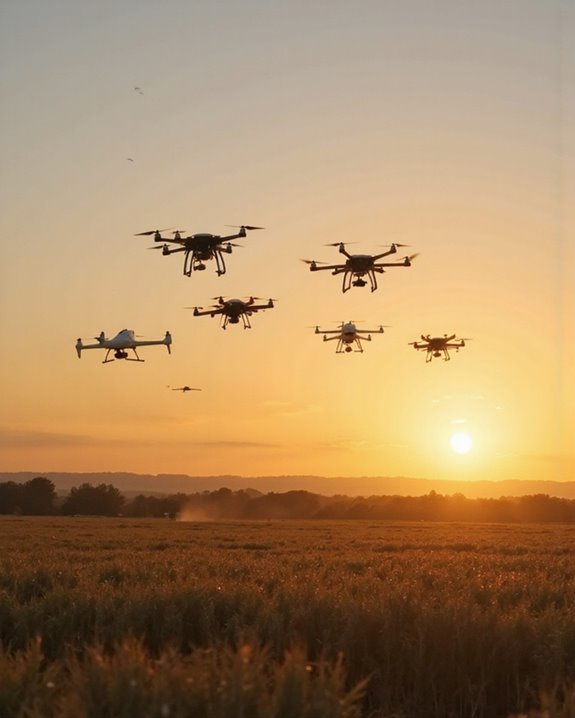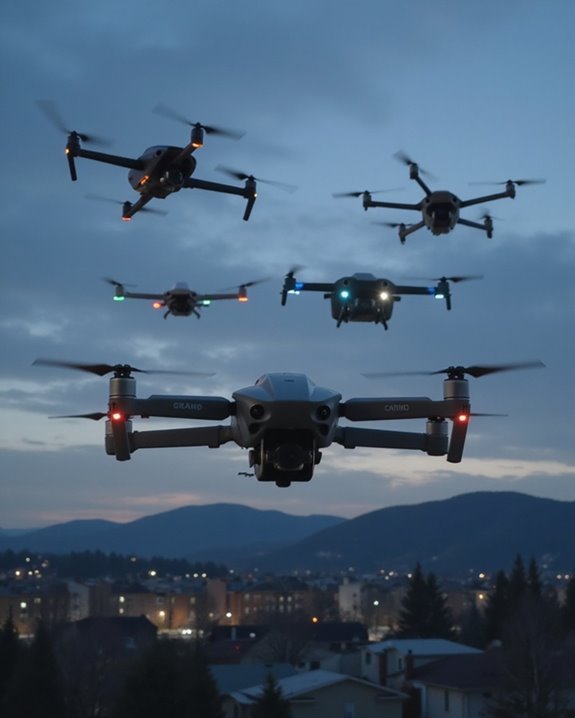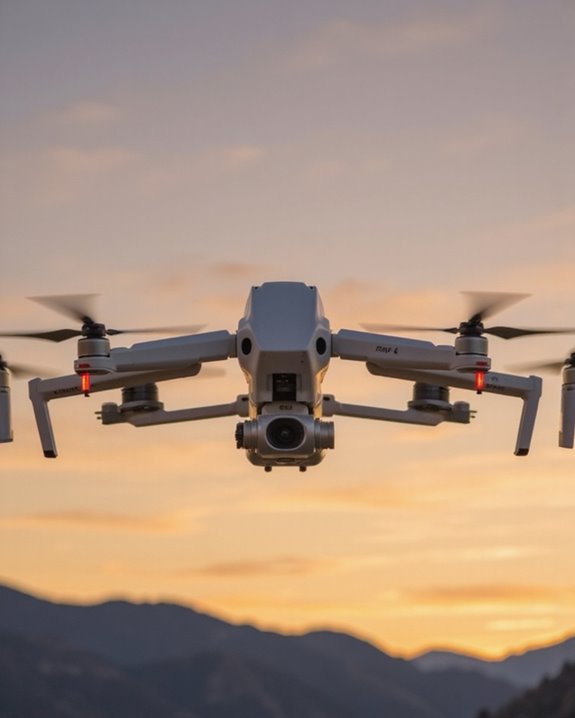You’ll find amazing options in today’s top flying drones! The X1 PRO 4K Foldable Drone captures stunning aerial footage with its stabilized camera, while the Force1 Scoot offers intuitive hand controls perfect for beginners. For the little ones, Tikduck’s Flying Orb Ball provides safe indoor fun with enclosed propellers. Each model balances flight time, portability, and smart features differently—from voice commands to obstacle avoidance. Discover which of these high-flyers matches your sky-high adventures!
Key Takeaways
- Flight time per charge ranges from 8-30 minutes across various drone models, with entry-level options offering 8-10 minutes.
- Camera quality varies with high-end drones capturing 4K@60fps footage with two-axis gimbals for smooth tracking.
- Portability features include foldable designs, enclosed propellers, and weights ranging from a few ounces to nearly 3 pounds.
- Safety technologies include 360° obstacle avoidance, Time-of-Flight sensors, and flexible ABS construction to prevent crashes and injuries.
- Control options feature smartphone operation, voice commands, and AI-powered automatic modes for various terrains and flight patterns.
X1 PRO 4K Foldable Drone with Camera
- 4K@60fps Cinematic Footage for Adventurers & Creators: Experience your adventures like never before with the HOVERAir X1 PRO action camera. Capture every detail in...
- Start Your Action with SmoothCapture 2.0: This mini drone features a two-axis gimbal with EIS (electronic image stabilization) and HL (horizon leveling) for steadier...
- Totally Handsfree: The HOVERAir drone with camera takes off from your hand easily with just a simple click or voice command, with no need for a controller or smartphone....
The adventure enthusiast’s dream companion, the X1 PRO 4K delivers exceptional aerial photography with its impressive 4K@60fps capability and advanced stabilization technology. You’ll capture stunningly smooth footage thanks to the two-axis gimbal and SmoothCapture 2.0 system, even when you’re zooming along at speeds up to 42 KM/H in follow mode!
Don’t worry about complicated controls—just use your voice for takeoff and your smartphone for the rest. With over 10 automatic modes and the ability to handle snow, water, and cliffs (yes, really!), you’re ready for any terrain. The drone’s collision detection keeps your investment safe, while 32GB of internal storage guarantees you won’t miss a moment of your next outdoor escapade!
Best For: Adventurous outdoor enthusiasts seeking a user-friendly drone that can capture high-quality aerial footage in challenging environments without requiring extensive piloting experience.
Pros:
- Captures impressive 4K@60fps footage with excellent stabilization technology for smooth results even during high-speed tracking
- Features hands-free voice command takeoff and smartphone-only operation with 10+ automatic modes for ease of use
- Versatile OmniTerrain capabilities allow for flying over diverse landscapes including snow, water, and cliffs
Cons:
- At 2.99 pounds, it’s relatively heavy compared to other portable drones, potentially affecting portability
- Limited collision detection (rear ToF sensor only) may not provide comprehensive obstacle avoidance in all directions
- Higher price point compared to entry-level drones with similar camera specifications
Force1 Scoot Hand Operated Drone for Kids and Adults
- ORIGINAL SCOOT DRONE FOR KIDS: Here’s the first, and the most-loved hand operated drone in Force1’s Scoot drone family! Toss to launch this hand drone into the air...
- INDOOR HOVER DRONE FOR BEGINNERS: Equipped with smart, obstacle avoidance motion sensors, use your hand to guide its flight, play modern catch with family and friends,...
- DURABLE AND SAFE WEBBED SHELL DESIGN: This flying toy drone is designed with a webbed shell that protects hands, walls, and furniture from the propellers; this webbed...
For families seeking a hands-free flying experience that won’t break the bank, this vibrant UFO-style drone delivers impressive functionality with a simple toss-to-launch design. You’ll love how the drone’s motion sensors respond to hand guidance, creating an interactive experience that feels almost magical.
The Scoot’s 360° obstacle avoidance technology prevents crashes while its webbed shell design protects little fingers from the propellers. With 8 minutes of flight time after a 50-minute charge, it’s perfect for quick indoor play sessions. At just 0.07 pounds, it’s lightweight enough for anyone 8 and up to enjoy—just don’t take it outdoors where wind might send your UFO to another galaxy!
Best For: Families with children ages 8 and up looking for a safe, interactive indoor drone that requires no remote control and provides a hands-free flying experience.
Pros:
- Motion-sensor technology allows for intuitive hand-guided flight without complicated controls
- Durable webbed shell design protects fingers from propellers and absorbs impacts during crashes
- 360° obstacle avoidance sensors help prevent damage to furniture and walls during indoor play
Cons:
- Limited 8-minute flight time after a 50-minute charging period
- Not suitable for outdoor use due to its lightweight design and wind sensitivity
- Some users report occasional erratic flight patterns and propeller damage after crashes
Tikduck Flying Orb Ball Mini Drone for Kids
- Super Cool High-Tech Hand Controlled Drone : Our flying orb ball featuring a gyroscope and smart AI chip that promises intelligent flight. Different throwing angles and...
- Lightweight Body: This flying ball drone toy is made of high-grade ABS material, which is lightweight and flexible, making it able to withstand countless crashes. The...
- USB Rechargeable: Simply connect it to the USB connector for 25 minutes to fully charge. (Flying time: 8 to 10 minutes). When the LED indicator flashes, it means that the...
Designed with younger pilots in mind, Tikduck Flying Orb Ball Mini Drone delivers a perfect blend of entertainment and educational value for children ages 6 and up. Its smart AI chip and gyroscope create impressive flight patterns, while the boomerang effect will have kids marveling at their own aerial wizardry!
You’ll appreciate the thoughtful safety features—enclosed propellers and flexible ABS material mean crashes won’t end in tears or broken toys. With a quick 25-minute charge yielding 8-10 minutes of flying time, it’s perfect for backyard adventures or indoor rainy-day fun. The 4.1-star rating from over 9,500 customers isn’t flying high without reason—this drone teaches physics while providing hours of challenging entertainment!
Best For: Children ages 6 and up who are interested in drones, flying toys, or hands-on STEM learning experiences that combine fun with educational concepts like physics and aerodynamics.
Pros:
- Safety-first design with fully enclosed propellers and durable, flexible ABS material prevents injuries and withstands inevitable crashes
- Smart AI chip and gyroscope technology create impressive flight patterns and boomerang effects that challenge and entertain kids
- Quick 25-minute charging time provides 8-10 minutes of flying time with LED indicators showing battery status
Cons:
- Limited 8-10 minute flying time per charge may frustrate children who want extended play sessions
- Some practice required to master different throwing techniques and flight patterns
- While suitable for outdoor use, may not perform optimally in windy conditions
Factors to Consider When Choosing a Flying Drone

When you’re ready to choose your perfect flying drone, there’s a handful of essential factors that’ll make or break your experience! You’ll want to evaluate everything from camera quality and flight time to the drone’s size, built-in safety features, and how you’ll control your new aerial companion. These five key considerations will help you navigate the overwhelming world of drones and find one that perfectly matches your specific needs, whether you’re capturing breathtaking aerial footage or simply enjoying recreational flights around your neighborhood.
Camera Quality
Don’t overlook frame rate! A camera shooting at 60fps or higher will deliver buttery-smooth footage when you’re zipping through the air or tracking moving subjects.
Stabilization is your best friend in the sky, where the slightest breeze becomes your nemesis. Look for drones equipped with electronic image stabilization or, better yet, a mechanical gimbal to keep your shots steady.
Consider the field of view too—90 to 120 degrees is typical—and don’t forget about low-light capabilities! Larger sensors will save your sunset shots from turning into grainy disappointments.
Flight Time
How long your drone stays aloft can make or break your aerial adventures! Most consumer drones offer between 5 and 30 minutes of flight per charge, with entry-level models typically hovering around the 8-10 minute mark. If you’re serious about capturing that perfect sunset shot, you’ll want a drone that gives you at least 10 minutes of uninterrupted flight.
Size and Portability
Just as battery life determines your airtime, the physical dimensions of your drone will shape your entire flying experience! When shopping for a flying companion, you’ll want to evaluate how easily it fits into your lifestyle. Today’s drones range from pocket-sized marvels under 4 inches to impressive behemoths exceeding 10 inches across.
Weight matters tremendously, with options spanning from featherlight few-ounce models to substantial multi-pound flyers. If you’re always on the move, look for foldable designs that collapse those extended arms into compact packages perfect for backpacks or even pockets! The best portable drones feature enclosed propellers and minimal bulk—no extra accessories required.
Safety Features
The difference between a thrilling flight and a costly disaster often comes down to your drone’s built-in safety features! Modern drones offer impressive protection systems that’ll keep both your investment and bystanders safe.
Look for models with Time-of-Flight sensors that detect potential collisions at speeds up to 1.5 m/s, automatically steering clear of obstacles before you even notice them! Enclosed propeller designs are a must-have if you’ll be flying near people, as they prevent those nasty finger nicks that can ruin your day.
High-grade ABS construction and webbed shells aren’t just marketing jargon—they’re essential for absorbing those inevitable first-time pilot crashes! Smart avoidance systems with multiple motion sensors create a virtual safety bubble around your drone, perfect for maneuvering tight spaces without turning your new toy into an expensive paperweight.
Control Method
Ever wondered why some drone pilots look like they’ve been flying their entire lives while others struggle just to keep their aircraft airborne? The secret often lies in finding the right control method for your skill level and needs!
Remote controllers offer precision flying with impressive range—perfect if you’re serious about mastering manual flight. For tech-savvy pilots, app-based systems turn your smartphone into a command center with live video feeds and cool automated modes. Voice commands let you launch with a simple “take off” when your hands are full, while gesture controls are surprisingly accurate (over 90%!) and perfect for beginners. Don’t overlook autonomous GPS navigation if you’re planning complex flight paths or want your drone to handle obstacle avoidance while you focus on capturing that perfect shot!
Intended Use
Finding your perfect drone starts with a simple question: what do you actually plan to do with it? A recreational flyer needs different features than someone shooting professional wedding videos, after all!
Indoor enthusiasts should look for compact models with propeller guards and obstacle avoidance sensors, while outdoor adventurers need wind resistance and longer battery life. Got kids? Prioritize enclosed propellers and simplified controls that won’t frustrate young pilots. For speed demons chasing the thrill of racing (up to a heart-pounding 60 km/h!), maneuverability trumps camera quality.
Your environment matters too. Planning to fly over water or snowy landscapes? You’ll want all-terrain capabilities and collision detection that works up to 1.5 meters away. Match your drone to your mission, and you’ll be zooming through the skies with confidence!
Weather Resistance
While matching your drone to your mission is essential, Mother Nature doesn’t always cooperate with your flying plans! That’s why weather resistance features should be high on your priority list when selecting your perfect flying companion.
Look for drones with IP ratings of IP54 or higher, which shield your investment from dust and water damage during unexpected light rain. Wind resistance specifications are vital too—models that can handle 10-20 m/s gusts will keep your footage stable when breezes kick up. Don’t forget about temperature tolerance! The best drones operate reliably between -10°C and 40°C, ensuring your aerial adventures aren’t limited by seasonal changes.
Premium models often feature sealed electronics and weatherproof casings that prevent moisture damage, while corrosion-resistant materials protect against everything from morning dew to salty coastal air!
Price Vs Features
How much drone can you actually get for your money? The drone market offers a fascinating cost-to-feature ratio that directly impacts your flying experience. Budget options under $100 will get you airborne with basic controls and 5-10 minutes of flight time—perfect if you’re just testing the waters!
Mid-range drones ($150-300) deliver noticeably better performance with speeds up to 30 km/h and improved stability for smoother videos. When you step up to premium models ($300+), you’re not just paying for the brand name! These high-flyers offer impressive 50+ km/h speeds, longer flight times, and game-changing features like GPS navigation and obstacle avoidance—worth the 30-50% price increase for serious enthusiasts. Remember, those electronic image stabilization systems might seem expensive, but you’ll thank yourself when you’re capturing butter-smooth footage in gusty conditions!
Frequently Asked Questions
What License or Permits Do I Need to Fly Drones Legally?
In the US, over 873,000 drones are now registered with the FAA, showing how important proper licensing has become! For recreational flying, you’ll need to register your drone if it’s heavier than 0.55 pounds and take the TRUST certification test online. For commercial use, you must obtain a Part 107 certificate by passing an FAA knowledge exam. Don’t forget to check local regulations too – some cities and parks have their own drone restrictions that might surprise you!
How Do Weather Conditions Affect Drone Performance and Battery Life?
Weather conditions dramatically impact your drone’s performance and battery life! Wind resistance forces motors to work harder, draining power faster. In cold temperatures, your battery efficiency plummets, sometimes reducing flight time by 30%. Hot weather isn’t much better, as it can overheat sensitive electronics. Rain and snow? Absolute drone killers for most models! For best results, fly on calm, dry days with moderate temperatures (60-75°F), and always pack extra batteries for those unexpected weather shifts.
Can I Fly My Drone Near Airports or Restricted Airspace?
No, you can’t fly your drone near airports or restricted airspace without proper authorization! Flying within 5 miles of airports requires FAA notification, and many areas have strict no-fly zones for safety reasons. Download the B4UFLY app to check restrictions in your area before takeoff. Breaking these rules could result in hefty fines, sometimes up to $20,000! Remember, safety comes first, and keeping your drone away from air traffic isn’t just smart—it’s the law!
What Are the Best Drones for Professional Aerial Photography?
For professional aerial photography, you can’t go wrong with the DJI Mavic 3 Pro or Autel EVO II Pro! These powerful drones capture stunning 4K footage with incredible stability and flight times exceeding 30 minutes. If you’re budget-conscious, consider the DJI Air 2S, which offers remarkable image quality at a lower price point. Remember, the best drone combines exceptional camera specs, reliable controls, and portability for your specific needs. Don’t forget to check payload capacity if you’re mounting additional equipment!
How Difficult Is It to Replace Drone Parts After Crashes?
Replacing drone parts after crashes isn’t too difficult! Most modern drones are designed with repairability in mind, with modular components you can swap out yourself. You’ll find plenty of tutorial videos online that walk you through the process step by step. The trickiest parts are usually propellers, motors, and camera gimbals, but with patience and the right tools, you’ll have your flying buddy back in action in no time. Just keep a small screwdriver set handy!








